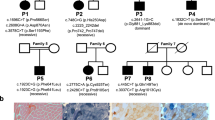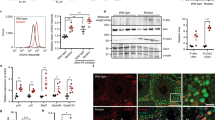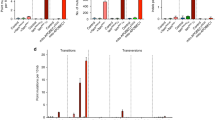Abstract
THE biogenesis of mitochondria depends on two sources of genetic information: one in the nucleus and the other within the mitochondria. An important question raised by this situation is how information from the two sources becomes integrated to form a functional organelle4,11. Products coded by both mitochondrial and nuclear DNA have been shown to be assembled in the mitochondrial inner membrane to form complex enzymes such as ATPase, cytochrome oxidase, cytochrome b and mutations in either genome can affect enzyme activity2,6,7,14. Since the activity of such enzymes depends on molecular interactions between their component subunits, it is conceivable that a defect in one subunit can be, at least partly, corrected by a mutation affecting another subunit. A nuclear mutation suppressing the effect of a mutated mitochondrial gene has been studied in Neurospora8. We report here the reverse situation.
This is a preview of subscription content, access via your institution
Access options
Subscribe to this journal
Receive 51 print issues and online access
$199.00 per year
only $3.90 per issue
Buy this article
- Purchase on Springer Link
- Instant access to full article PDF
Prices may be subject to local taxes which are calculated during checkout
Similar content being viewed by others
References
Adoutte, A., and Beisson, J., Nature, 235, 393–396 (1972).
Avner, P. R., and Griffiths, D. E., Eur. J. Biochem., 32, 312–321 (1973).
Beisson, J., Sainsard, A., Adoutte, A., Beale, G., Knowles, J., and Tait, A., Genetics, 78, 403–413 (1974).
Boardman, N., Linnane, A. and Smillie, R. (edits), Autonomy and Biogenesis of Mitochondria and Chloroplasts (North Holland, Amsterdam, 1971).
Borst, P., A. Rev. Biochem., 41, 333–376 (1972).
Griffiths, D. E., Houghton, R. L., Lancashire, W. E., and Meadows, P. A., Eur. J. Biochem., 51, 393–402 (1975).
Lancashire, W. E., and Griffiths, D. E., Eur. J. Biochem., 51, 377–393 (1975).
Mitchell, M. B., and Mitchell, H. K., J. gen. Microbiol., 14, 84–89 (1956).
Perasso, R., and Adoutte, A., J. Cell. Sci., 14, 475–497 (1974).
Sainsard, A., Claisse, M., and Balmefrezol, M., Molec. gen. Genet., 130, 113–125 (1974).
Schatz, G., and Mason, T. L., A. Rev. Biochem., 43, 51–87 (1974).
Sonneborn, T. M., in Methods in Cell Physiology, 4, 241ndash;339 (1970).
Sonneborn, T. M., Trans. Am. microsc. Soc., 94, 155–178 (1975).
Tzagoloff, A., Akai, A., and Needleman, R. B., J. Bact., 122, 826–831 (1975).
Author information
Authors and Affiliations
Rights and permissions
About this article
Cite this article
SAINSARD, A. Mitochondrial suppressor of a nuclear gene in Paramecium. Nature 257, 312–314 (1975). https://doi.org/10.1038/257312a0
Received:
Accepted:
Published:
Issue Date:
DOI: https://doi.org/10.1038/257312a0
This article is cited by
-
Manifestation of carcinogenesis as a stochastic process on the basis of an altered mitochondrial genome
Archiv f�r Toxikologie (1981)
-
A new type of mitochondrial mutation in Paramecium
Molecular and General Genetics MGG (1978)
-
Mitochondrial genes inPodospora anserina: Recombination and linkage
Molecular and General Genetics MGG (1977)
-
Carbomycin resistance in mouse L cells
Somatic Cell Genetics (1977)
-
A cytoplasmic gene for partial suppression of a nuclear pleiotropic respiratory deficient mutant in the petite negative yeast Schizosaccharomyces pombe
Molecular and General Genetics MGG (1976)
Comments
By submitting a comment you agree to abide by our Terms and Community Guidelines. If you find something abusive or that does not comply with our terms or guidelines please flag it as inappropriate.



